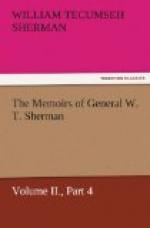The construction of the Union Pacific Railroad was deemed so important that the President, at my suggestion, constituted on the 5th of March, 1866, the new Department of the Platte, General P. St. George Cooke commanding, succeeded by General C. C. Augur, headquarters at Omaha, with orders to give ample protection to the working-parties, and to afford every possible assistance in the construction of the road; and subsequently in like manner the Department of Dakota was constituted, General A. H. Terry commanding, with headquarters at St. Paul, to give similar protection and encouragement to the Northern Pacific Railroad. These departments, with changed commanders, have continued up to the present day, and have fulfilled perfectly the uses for which they were designed.
During the years 1865 and 1866 the great plains remained almost in a state of nature, being the pasture-fields of about ten million buffalo, deer, elk, and antelope, and were in full possession of the Sioux, Cheyennes, Arapahoes, and Kiowas, a race of bold Indians, who saw plainly that the construction of two parallel railroads right through their country would prove destructive to the game on which they subsisted, and consequently fatal to themselves.
The troops were posted to the best advantage to protect the parties engaged in building these roads, and in person I reconnoitred well to the front, traversing the buffalo regions from south to north, and from east to west, often with a very small escort, mingling with the Indians whenever safe, and thereby gained personal knowledge of matters which enabled me to use the troops to the best advantage. I am sure that without the courage and activity of the department commanders with the small bodies of regular troops on the plains during the years 1866-’69, the Pacific Railroads could not have been built; but once built and in full operation the fate of the buffalo and Indian was settled for all time to come.
At the close of the civil war there were one million five hundred and sixteen names on the muster-rolls, of which seven hundred and ninety-seven thousand eight hundred and seven were present, and two hundred and two thousand seven hundred and nine absent, of which twenty-two thousand nine hundred and twenty-nine were regulars, the others were volunteers, colored troops, and veteran reserves. The regulars consisted of six regiments of cavalry, five of artillery, and nineteen of infantry. By the act of July 28, 1866, the peace establishment was fixed at one general (Grant), one lieutenant-general (Sherman), five major-generals (Halleck, Meade, Sheridan, Thomas, and Hancock), ten brigadiers (McDowell, Cooke, Pope, Hooker, Schofield, Howard, Terry, Ord, Canby, and Rousseau), ten regiments of cavalry, five of artillery, and forty-five of infantry, admitting of an aggregate force of fifty-four thousand six hundred and forty-one men.




